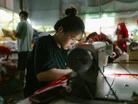Remanufacturing: A Fitting Fashion Sustainability Solution

Fashion is at the heart of many of the world’s biggest supply chains. Contributing in excess of US$2tr to the global economy, this colossal industry employs more than 75 million people, with 40 million working directly in the garment and footwear industry.
Little wonder, then, that fashion’s wider impact is under a microscope and constantly making headlines – often for the wrong reasons. The rise of fast fashion has only contributed to these problems, creating economic models that rely on exploitation and ecological pollution to meet the demand for cheap, quick-and-easy clothing.
We all know fashion needs to change, but, for this to happen, we must think about the bigger picture. This is more than just a question for individual manufacturers – it’s also one for the broader supply chain.
Some of the biggest names in fashion pondered this question at the Manufacturing Futures Innovation Awards, a programme aimed at arming scalable startup innovations with the capacity to change fashion manufacturing and the broader supply chain. Judges like Adam Mansell, CEO of UKFT, the British Textile and fashion network, shared their expert perspectives on the obstacles fashion manufacturing faces.
“The biggest problem that the industry faces is sustainability,” he said, “whether that's sustainability in terms of raw materials or in terms of business sustainability.”
Adam highlighted the need for “big solutions” to address this sustainability crisis, echoing the need for changes throughout the value chain.
“When we look at a brand that’s designing stuff, designing it in a sustainable way – that’s great, that’s brave, that’s important,” he added. “But what really interests me is those big innovations that are going to shift the dial in terms of how we approach things.”
Ella Gould, Head of Sustainability and Innovation at Selfridges, and another judge at the event, agreed.
“The really exciting thing for me was looking at that entire supply chain, looking at all the different problems we’ve created for ourselves as an industry and coming up with novel solutions,” she continued.
“Today has really got me thinking about how we can be a better connector, as we’re pushing our brands to do more across this space, whether its carbon production, material innovation, or circular business practices – all of which come under my team.”
Selfridges is already making major strides through its rental and pre-owned offerings, in addition to RESELFRIDGES, an innovative initiative that puts reducing waste, recycling materials and remanufacturing at the heart of Selfridges operations.
Remanufacturing is a sustainability solution set only to grow.
Remanufacturing: A sustainability solution
Remanufacturing is when companies take used or old parts and products, dismantle them and return them to a like-new, same-as-new or better-than-new condition. Remanufactured fashion operates under the same waste management principle, converting discarded garments into useful retail products instead of dumping them in landfill.
“Remanufacturing aligns with the circular economy principles by extending the lifecycle of products and minimising waste,” says Andrew Burton, Global Industry Director for Manufacturing at IFS. “It emphasises reusing, repairing and refurbishing products instead of disposing of them. This approach reduces the need for new raw materials and lowers carbon emissions associated with manufacturing.”
According to the European Remanufacturing Network (ERN), remanufacturing has an EU market potential of €90bn (US$99bn) by 2030. This projection is driven by regulatory pressures, growing prioritisation of sustainability and the rise of circular economic practices. Remanufacturing also offers significant financial benefits, according to Andrew.
“One of the primary benefits is cost savings, as it reduces the need for raw materials and energy-intensive manufacturing processes,” he says. “Companies can also realise savings by reusing components and materials, lowering production costs.”
Global fashion brands are embracing remanufacturing for all these reasons and more. Patagonia Worn Wear, Levi’s SecondHand and Urban Outfitters are among those remanufacturing offshoots of their iconic brands.
However, to increase the prevalence of remanufacturing, companies must move from implementing it as a siloed solution to undergoing holistic supply chain evolution.
“Companies are recognising the benefits of reducing their carbon footprints and extending the life cycle of their products,” comments Maggie Slowik, Global Industry Director for Manufacturing at IFS.
“To position themselves to benefit from this growth, companies should invest in developing circular business models that focus on remanufacturing.
“This involves rethinking product design to enhance durability and ease of disassembly, implementing effective return logistics systems and utilising technologies such as AI for better forecasting and inventory management.
“Additionally, companies should engage in collaborations within the ecosystem to find new uses for their waste materials, thereby creating new business opportunities and reducing dependency on raw materials.”
While remanufacturing poses revolutionary possibilities, it also comes with extensive barriers to adoption.
These barriers include price competitiveness for remanufactured products, legal barriers like restrictions on product design, the ongoing skills shortage and securing a good, consistent supply of end-of-life core returns.
Handling logistics is also a challenge, as Andrew explains: “One major barrier to full adoption of remanufacturing practices is the challenge of setting up effective return logistics systems to retrieve used products.
“Manufacturers need to establish mechanisms for collecting, assessing and processing returned items. Another barrier is the need for new business models and processes that support the circular economy.
“Overcoming these barriers requires companies to invest in technology that supports remanufacturing, such as advanced tracking systems and the latest high-quality inventory management solutions, with AI increasingly adding more functionality.”
In addition to AI, Maggie points to the power of partnerships: “Fostering partnerships within the industry can help create a more robust ecosystem for sharing and reusing materials.
“Regulatory incentives and consumer demand for sustainable products can also drive wider adoption of remanufacturing practices.”
Despite the challenges, Maggie and Andrew both foresee a future full of remanufacturing, where sustainable materials and emerging technologies help boost the feasibility and success of circular business models. A key factor in building this future will be growing market demand for sustainable goods.
According to PwC’s Voice Of The Consumer survey, consumers in 2024 are willing to spend an average of 9.7% more on sustainable goods, even during a cost-of-living crisis.
Many fashion consumers are fiercely committed to ethical and sustainable shopping, contributing to the success of esteemed sustainable designer Stella McCartney and the rise of new brands like Lucy and Yak.
“Consumer demand for sustainable products will continue to rise, leading to greater market acceptance and growth of remanufactured goods,” Andrew says.
“Companies that embrace these trends and invest in innovation will be well-positioned to thrive in the evolving remanufacturing landscape.”
The barriers to remanufacturing – particularly logistics and supply – all originate within the supply chain. For this reason, fashion manufacturers must build a resilient, well-managed supply chain foundation to pursue remanufacturing successfully as an overarching, long-term strategy.
Successfully managing the supply chain
The fashion supply chain is vast and complex, with a multitude of global players and stakeholders.
Sustainability requires sustained, collaborative effort and the collective overhaul of systems the modern world has relied on for hundreds of years. One such system is the ever-evolving supply chain.
“As global markets continue to become more interconnected and some, unfortunately, more volatile, supply chain management continues to grow in importance,” says Rob Wright, Executive Director at SCALA Consulting.
“With effective supply chain management processes in place, global manufacturers can drive operational efficiency, resilience, sustainability and competitive advantage.”
Rob asserts that embracing sustainability in and of itself comprises a form of effective supply chain management.
“Supply chain efficiency comes hand in hand with sustainability,” he goes on. “By introducing more sustainable practices, manufacturers can benefit from cost savings, improved reputation and increased resilience.
“For example, by reducing energy and raw material usage, manufacturers are not only impacting their carbon emissions but also lessening their energy and material costs. This can be done through optimised transport processes, recycling and using sustainable materials.”
By reducing costs, fashion manufacturers can enhance business value and increase supply chain stability, making their transition to remanufacturing smoother.
“Having a supply chain that operates on lower margins will enhance overall business profitability and drive value,” Rob adds.
“Additionally, aligning the supply chain with wider business objectives can also generate value. By doing so, business leaders are ensuring every aspect of the chain supports and enhances the company’s broader goals.”
In addition to integrating sustainability, Rob says effective supply chain management can also mean increasing resilience, embracing Industry 4.0, utilising long-term demand forecasting and mitigating risk.
“I would encourage manufacturers to remember that supply chain management is a continuous process; there is no quick fix,” he concludes.
“Manufacturers should be regularly reviewing their supply chain to ensure they are maximising their management processes. This could include integrating a new tech system, partner or supplier to streamline operations and maximise growth.”
By creating a strong supply chain foundation, fashion manufacturers will be ready to pursue strategies like remanufacturing, creating hope for a brighter future in the industry.
The Manufacturing Futures Innovation Awards was a beacon in this regard, highlighting the dedication many have across the fashion supply chain to creating sustainable change.
To read the full story in the magazine click HERE
**************
Make sure you check out the latest edition of Manufacturing Digital and also sign up to our global conference series - Procurement & Supply Chain 2024 & Sustainability LIVE 2024
******
Manufacturing Digital is a BizClik brand.
- Henkel: Optimising Washing Through Autonomous SensorsSustainability & ESG
- BMW: Creating Economic Circularity through Battery CreationSustainability & ESG
- Aggreko: UK Energy Manufacturers must Shore Up Supply ChainSustainability & ESG
- Capgemini: Gen AI Cause of Spiking Semiconductor DemandAI & Automation


